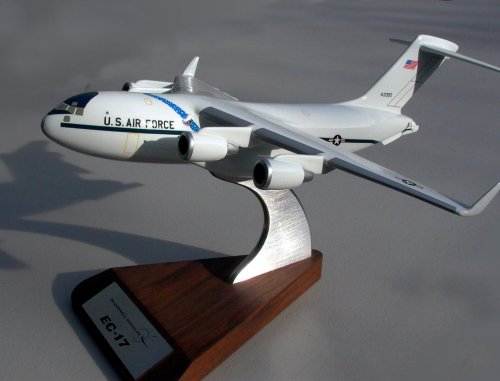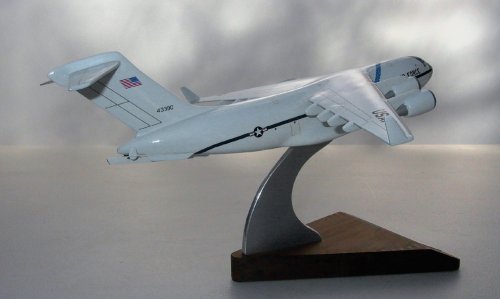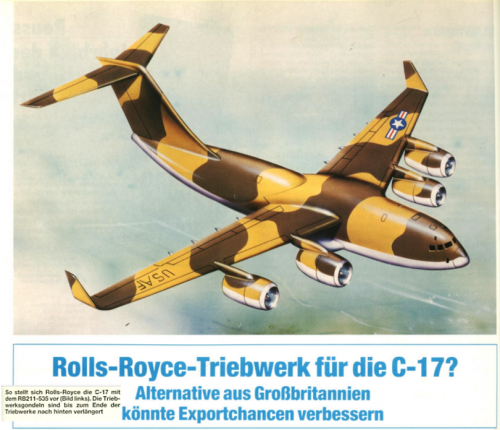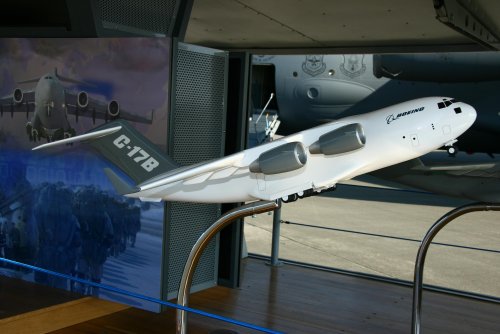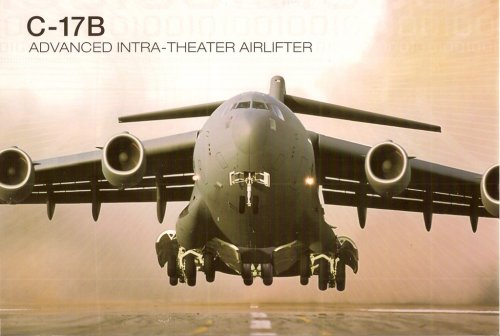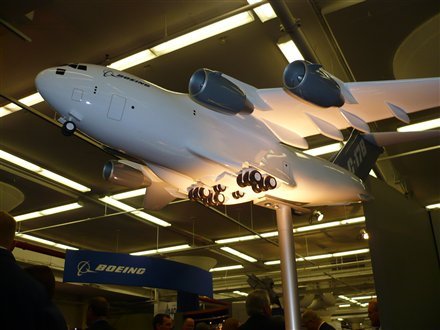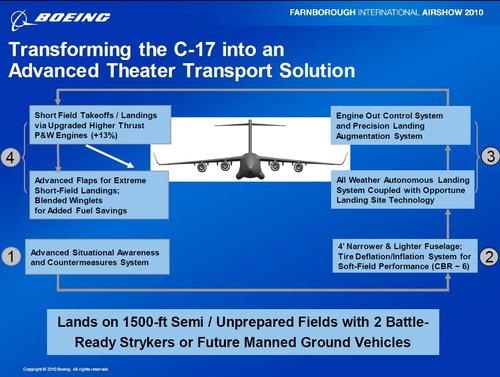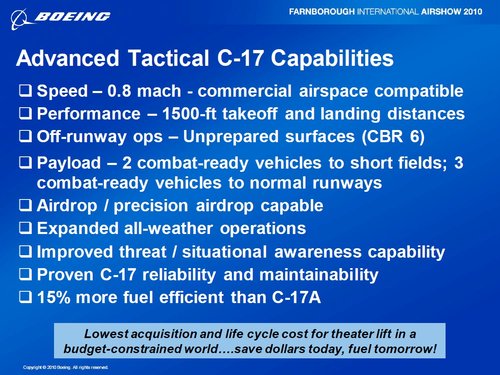You are using an out of date browser. It may not display this or other websites correctly.
You should upgrade or use an alternative browser.
You should upgrade or use an alternative browser.
C-17B Globemaster
- Thread starter masqqqq
- Start date
- Joined
- 3 June 2006
- Messages
- 2,828
- Reaction score
- 2,490
Re: C-17 Globemaster projects
In 1992, McDonnell Douglas Corp. was talking with British jet-engine builder Rolls-Royce plc about putting Rolls-Royce RB211-535 turbofan engines on the Douglas-built C-17
Source: Luftwaffen-Forum, 01-1993, pages 44-45
In 1992, McDonnell Douglas Corp. was talking with British jet-engine builder Rolls-Royce plc about putting Rolls-Royce RB211-535 turbofan engines on the Douglas-built C-17
Source: Luftwaffen-Forum, 01-1993, pages 44-45
Attachments
- Joined
- 21 April 2009
- Messages
- 13,138
- Reaction score
- 5,958
From AFA:
Two C-17s drop-launched a pair of ballistic target missiles near Wake Island in the Pacific Ocean, supporting a recent Missile Defense Agency test. "High-altitude, heavy weight airdrop is something we're doing a lot of here at Edwards, supporting not only MDA, but NASA with the Orion capsule drops that we've been doing," 418th Flight Test Squadron pilot Capt. Stephen Koether from Edwards AFB, Calif., said in a Dec. 7 release. Edwards pilots initially deployed a Short-Range Air-Launch Target (SRALT) from the C-17's cargo bay, which was detected, tracked, and intercepted by a ground-launched Terminal High Altitude Area Defense (THAAD) missile. The second Globemaster launched a larger Extended Medium-Range Ballistic Missile (EMRBM) minutes later, testing defensive systems' ability to discriminate targets through debris from the first shot. The THAAD system on Wake successfully intercepted the first shot, and although the AEGIS destroyer USS John Paul Jones was able to track the EMRBM, its SM-3 missile failed to engage, according to an MDA release. The Oct. 31 test evaluated both land- and sea-based US missile defense. MDA is investigating the missile interceptor failure.
Two C-17s drop-launched a pair of ballistic target missiles near Wake Island in the Pacific Ocean, supporting a recent Missile Defense Agency test. "High-altitude, heavy weight airdrop is something we're doing a lot of here at Edwards, supporting not only MDA, but NASA with the Orion capsule drops that we've been doing," 418th Flight Test Squadron pilot Capt. Stephen Koether from Edwards AFB, Calif., said in a Dec. 7 release. Edwards pilots initially deployed a Short-Range Air-Launch Target (SRALT) from the C-17's cargo bay, which was detected, tracked, and intercepted by a ground-launched Terminal High Altitude Area Defense (THAAD) missile. The second Globemaster launched a larger Extended Medium-Range Ballistic Missile (EMRBM) minutes later, testing defensive systems' ability to discriminate targets through debris from the first shot. The THAAD system on Wake successfully intercepted the first shot, and although the AEGIS destroyer USS John Paul Jones was able to track the EMRBM, its SM-3 missile failed to engage, according to an MDA release. The Oct. 31 test evaluated both land- and sea-based US missile defense. MDA is investigating the missile interceptor failure.
Model of Boeing C-17B
Source:
http://www.avgeekery.com/2015314three-c-17-derivatives-that-never-took-off/
http://bemil.chosun.com/nbrd/gallery/view.html?b_bbs_id=10040&pn=5&num=45696
Another potential derivative was the Boeing C-17B. If you ever attended an airlift convention or airshow, you might have even seen a model of the upgraded Globemaster III. The C-17B was pitched as a way to allow landings at truly austere fields in locations where the “A” model couldn’t go. The C-17B featured a center-truck gear, self-deflating tires and double-slotted flaps to allow landing on even shorter distances. This variant was proposed a few times by Boeing in an attempt to extend the production line, the last time publicly in 2008. The “B” model never caught on though. The C-17 was already an expensive plane to operate and by 2008, congress started to reign in the massive defense budget that would have been necessary to fund this new variant. The War on Terror showed off the capabilities of the C-17 but it also exemplified that performance beyond its current capabilities were not required. Most missions did not require landing on a short or unimproved field. Even in poor nations like Afghanistan, most of the cargo could be delivered to a few established fields and transloaded to smaller aircraft like C-130s and/or convoyed to the final destination.
Source:
http://www.avgeekery.com/2015314three-c-17-derivatives-that-never-took-off/
http://bemil.chosun.com/nbrd/gallery/view.html?b_bbs_id=10040&pn=5&num=45696
Attachments
- Joined
- 9 October 2009
- Messages
- 19,771
- Reaction score
- 10,218
- Joined
- 25 January 2020
- Messages
- 1,052
- Reaction score
- 1,461
Model of Boeing C-17B
Another potential derivative was the Boeing C-17B. If you ever attended an airlift convention or airshow, you might have even seen a model of the upgraded Globemaster III. The C-17B was pitched as a way to allow landings at truly austere fields in locations where the “A” model couldn’t go. The C-17B featured a center-truck gear, self-deflating tires and double-slotted flaps to allow landing on even shorter distances. This variant was proposed a few times by Boeing in an attempt to extend the production line, the last time publicly in 2008. The “B” model never caught on though. The C-17 was already an expensive plane to operate and by 2008, congress started to reign in the massive defense budget that would have been necessary to fund this new variant. The War on Terror showed off the capabilities of the C-17 but it also exemplified that performance beyond its current capabilities were not required. Most missions did not require landing on a short or unimproved field. Even in poor nations like Afghanistan, most of the cargo could be delivered to a few established fields and transloaded to smaller aircraft like C-130s and/or convoyed to the final destination.
Source:
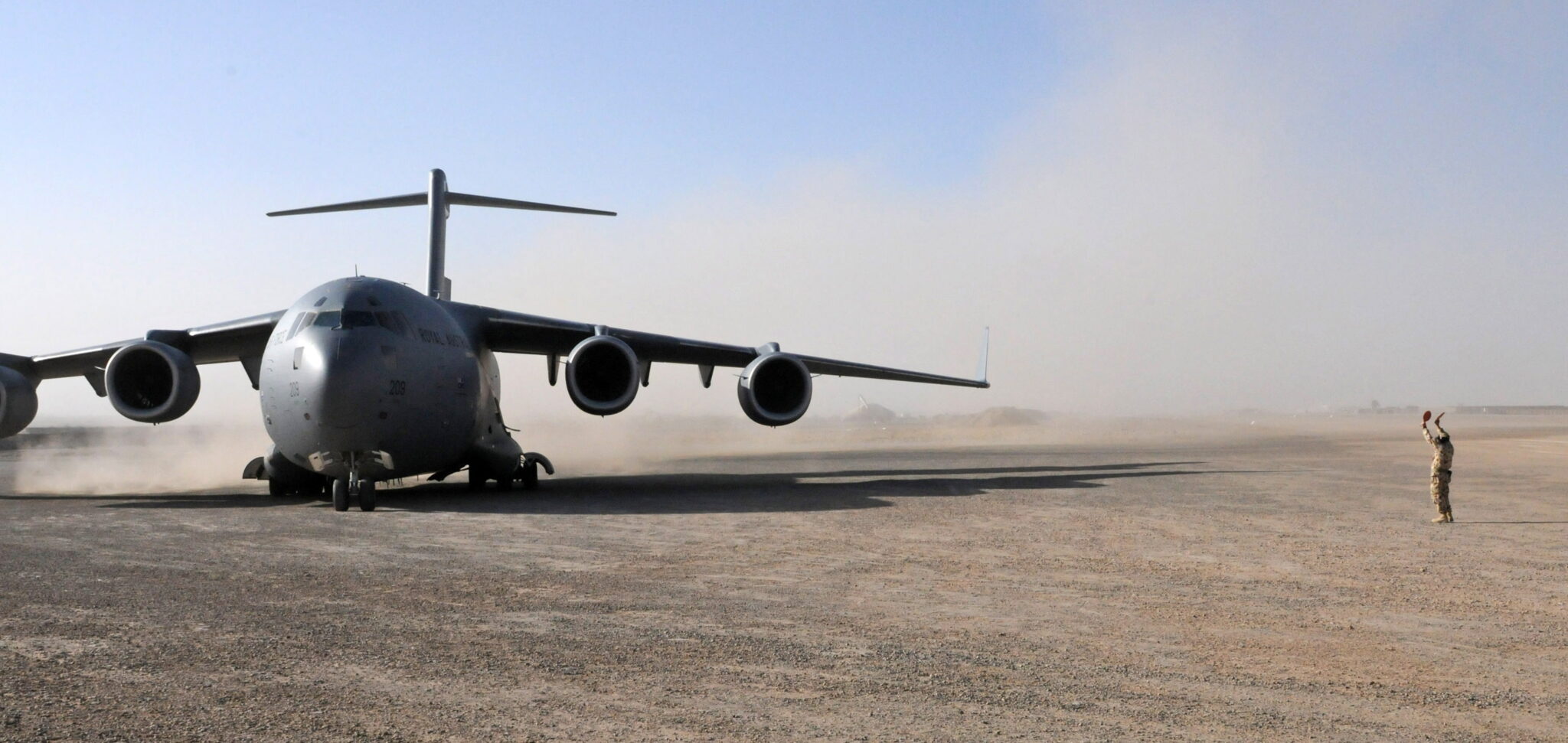
Three types of C-17 That Never Made It Off The Drawing Board
The C-17 was a successful design. Here are 3 modifications to the C-17 that never made it off the drawing board.www.avgeekery.com¹Ì À°±ºÀ» »ó´ë·Î Á¦¾ÈµÇ°í ÀÖ´Â C-17B ¼ö¼Û±â
¹Ì À°±ºÀ» »ó´ë·Î Á¦¾ÈµÇ°í ÀÖ´Â C-17B ¼ö¼Û±âbemil.chosun.com
How would the C-17B differed from the C-17A?
- Joined
- 1 April 2006
- Messages
- 10,719
- Reaction score
- 6,675
How would the C-17B differed from the C-17A?
Attachments
Makes you wonder if they modded say 3 airframes, the tyres and engines would be straightforward to do, the flaps etc a little harder. Handy for those places you never go, if you see what I mean. And would look pretty much like regular C17....How would the C-17B differed from the C-17A?
- Joined
- 25 January 2020
- Messages
- 1,052
- Reaction score
- 1,461
Thanks! I still need to order the book though, I've been needing to do so for some time. I will order it as soon as possible.
Adventurer104
Retired Texas Peace Officer
- Joined
- 5 July 2013
- Messages
- 49
- Reaction score
- 14
4 in narrower fuselage?How would the C-17B differed from the C-17A?
to lighten or some other purpose?
- Joined
- 16 April 2008
- Messages
- 8,350
- Reaction score
- 10,156
4 in narrower fuselage?How would the C-17B differed from the C-17A?
to lighten or some other purpose?
Not 4 inches, 4 feet (~1.2 meters). That's a pretty dramatic shrink, which would eliminate the ability to haul heavy tanks, but I guess would still accomodate Stryker (and maybe Bradley?). Would certainly be quite a weight and fuel savings, though. Combined with the higher flotation landing gear, it could make the
Edit: Realized that those slides likely refer to the FE, not the B.
Last edited:
- Joined
- 16 April 2008
- Messages
- 8,350
- Reaction score
- 10,156
That would make it the same diameter as an A400M Tom, was it intended to compete with it ---
Presumably. Turned out to be a very small market indeed.
- Joined
- 18 October 2006
- Messages
- 3,861
- Reaction score
- 3,672
Given the damage to C-130's operating out of "austere" landing locations, I suspect the USAF was loathe to risk a capitol asset to an unseen rock. I would like to poke them in the eye for that, but I can understand the rational.
brownt62
Be kind to children.
- Joined
- 17 December 2012
- Messages
- 21
- Reaction score
- 21
Question....Could the C-17A be stretched like the C-141A was stretched to make the C-141B? Seems like a cheap way to gain some capability at a more reasonable cost than new builds. I dont know if the C-17 cubes out before exceeding weight lifting limits...
isayyo2
Lurker alert
- Joined
- 24 November 2011
- Messages
- 1,034
- Reaction score
- 1,867
It’s all very Future Combat System vibe-y, the Army and Shinseki really believed they could move a light-mech Brigade in 96 hours and they needed all the lift assets possible. There are some FCS slides floating around showing the need for intra-theater planes.4 in narrower fuselage?How would the C-17B differed from the C-17A?
to lighten or some other purpose?
Not 4 inches, 4 feet (~1.2 meters). That's a pretty dramatic shrink, which would eliminate the ability to haul heavy tanks, but I guess would still accomodate Stryker (and maybe Bradley?). Would certainly be quite a weight and fuel savings, though. Combined with the higher flotation landing gear, it could make theC-17BC-17FE more capable in unprepared runways.
Edit: Realized that those slides likely refer to the FE, not the B.
alejandrogrossi
ACCESS: Secret
- Joined
- 20 September 2019
- Messages
- 218
- Reaction score
- 321
never saw itMcDonnell Douglas EC-17 tanker, flying command post and electronic warfare platform:
I like the tanker version.
No pods for Navy planes
alejandrogrossi
ACCESS: Secret
- Joined
- 20 September 2019
- Messages
- 218
- Reaction score
- 321
circle-5McDonnell Douglas EC-17 tanker, flying command post and electronic warfare platform:
Question
If any wants the EC-17 tanker (with boom an with pods in the wing) MCD can build it?
- Joined
- 13 June 2007
- Messages
- 2,017
- Reaction score
- 2,209
Sad to say, Circle-5 passed away a few years ago.....circle-5McDonnell Douglas EC-17 tanker, flying command post and electronic warfare platform:
Question
If any wants the EC-17 tanker (with boom an with pods in the wing) MCD can build it?
As to your question, don't see Boeing offering that option. They'll try to sell you converted 767s instead.
Mark
- Joined
- 16 April 2008
- Messages
- 8,350
- Reaction score
- 10,156
circle-5McDonnell Douglas EC-17 tanker, flying command post and electronic warfare platform:
Question
If any wants the EC-17 tanker (with boom an with pods in the wing) MCD can build it?
So, obviously, McDonnell Douglas hasn't existed as a separate company in ages and I think the name hasn't even been used since ~2001 or so (I've lost track). It's all Boeing now. Also, Boeing stopped making C-17s in 2015 and then sold the plant to real estate developers in 2019. So not only has the horse left the barn, the barn is being torn down and turned into condos.
Last edited:
alejandrogrossi
ACCESS: Secret
- Joined
- 20 September 2019
- Messages
- 218
- Reaction score
- 321
My badSad to say, Circle-5 passed away a few years ago.....circle-5McDonnell Douglas EC-17 tanker, flying command post and electronic warfare platform:
Question
If any wants the EC-17 tanker (with boom an with pods in the wing) MCD can build it?
As to your question, don't see Boeing offering that option. They'll try to sell you converted 767s instead.
Mark
Thanks for you ansewer
Similar threads
-
Air Force C-17 Globemaster III makes surprise landing at Peter O. Knight Airport
- Started by Graham1973
- Replies: 3
-
-
-
-
US Navy/USMC Assault Helicopter competitions (1950-51)
- Started by Stargazer
- Replies: 5

